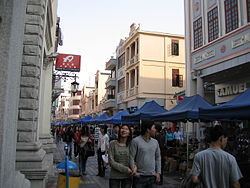Population 948,716 (2000) | Area 3,285.91 km2 | |
 | ||
Map of Taishan
Taishan, formerly romanized in Cantonese as Toishan, in local dialect as Hoisan, and formerly known as Xinning or Sunning, is a county-level city in southwestern Guangdong, China. It is administered as part of the prefecture-level city of Jiangmen. During the 2010 census, there were 941,095 inhabitants, of which 394,855 were classified as urban. Taishan calls itself the "First Home of the Overseas Chinese". An estimated half a million Chinese Americans are of Taishanese descent.
Contents
- Map of Taishan
- Toisan flying tiger mountain in china taishan
- Taishan china 2016
- Geography
- History
- Administration
- Demographics
- Language
- Claims to fame
- Power stations
- Education
- Transportation
- References

Toisan flying tiger mountain in china taishan
Taishan china 2016
Geography

Taishan is located in the Pearl River Delta in southwestern of Jiangmen Prefecture. It contains 95 islands and islets, including Shangchuan Island, the largest island in Guangdong now that Hainan has become a separate province. Taishan is one of Guangdong's "Four Counties" (Sze Yup), which excluded Heshan and is now part of the Greater Taishan Region.
History

During the Ming dynasty, the area of present-day Taishan was carved out of Xinhui County on 12 February 1499 as Xinning County. Xinning was a source of migrant and emigrant workers, but a series of natural and political disasters in the 19th century exacerbated the situation. Aside from the disruption of the Sea Ban regulations (Haijin) themselves, their revocation led to an influx of northern settlers who began long-running feuds with the returning locals; this erupted into full-scale war in the 1850s and '60s. The 1842 Treaty of Nanjing that ended the First Opium War opened China to greater foreign trade just before the California Gold Rush made the prospect of emigration to the United States appealing. Many also served as "coolie" contract workers abroad, as in Hawaii and Cuba and—most famously—for the Central Pacific half of America's Transcontinental Railroad, where the Chinese made up 80% of the company's workforce as they laid track over the mountains and deserts of the west. By 1870, there were 63,000 Chinese in the United States, almost all in California.

Chin Gee Hee's Sun Ning Railway Company connected Xunning with its hinterland in 1908 and reached Jiangmen in 1913. It was notable as one of only three financed, built, owned, and run by the Chinese themselves prior to the 1949 Communist victory in the Chinese Civil War.
In 1914, the new republican government renamed the area Taishan County to avoid confusion with other places named Xinning. (It is now, however, frequently confused in foreign sources with Mount Tai in Shandong.) During the Second World War, the Xinning Railway was destroyed to prevent its use by the Japanese. Japanese soldiers entered Taicheng, the county seat, in March 1941 and killed nearly 280 people.
Taishan was promoted to county-level city status on 17 April 1992, reflecting its increasing level of urbanization.
Administration
A part of Jiangmen, Taishan covers 3,286 km2 (1,269 sq mi) and is subdivided into 16 towns, which are in turn subdivided into 313 village residential committees (村居委会) and 3,655 natural villages (自然村).
These Towns are:
These “Natural Villages” (自然村) include:
Demographics
If considering the total Greater Taishan Region or Sze Yap Region, which includes Kaiping, Xinhui, Enping and Taishan, there are about 8 to 9 million Taishanese people worldwide. According to American historian Him Mark Lai, approximately 430,000 or 70% of Chinese Americans in the 1980s were Taishanese according to 1988 data. Currently some 500,000 Chinese Americans claim Taishanese origins.
While Taishan itself has a population of about 1 million, there are around 1.3 million Taishanese people overseas, distributed in 91 countries and regions. It is estimated that, up to the mid- to late-20th century, over 75% of all overseas Chinese in North America claimed origin in Taishan, so Taishan has been named the "Home of Overseas Chinese."
Language
The main language of Taishan is Taishanese (台山話). While most Taishanese today use Mandarin in school or formal occasions, Taishanese is the de facto language. Schools require their students to speak Mandarin in the classroom, and teachers are required to lecture in Mandarin.
Taishanese is a language of the Yue Chinese, a large group which includes, but is broader than, the Cantonese spoken in Hong Kong and Guangzhou. Thus Cantonese and Taishanese are related but distinct. Cantonese is also widely known in Taishan, as it serves as the lingua franca of Guangdong Province.
Before the 1980s, Taishanese was the predominant Chinese language spoken throughout North America's Chinatowns.
Claims to fame
Taishan is the birthplace of Chinese volleyball which was introduced by Overseas Chinese. Its teams have won many provincial and national championships.
Taishan and Guangzhou are the birthplaces of Guangdong music.
One quarter of the “Flying Tigers” came from Taishan. This “legendary” group of American airmen fought the Japanese prior to the United States entering the Second World War.
Taishan hosts Jiangmen Star Park which has produced more international Chinese celebrities than any other region or city in China.
Parts of the movie Let the Bullets Fly were filmed in Taishan in 2010.
Power stations
Electricity for Taishan is generated by the:
Education
Education enjoys significant support from Overseas Chinese professionals and businessmen. Many secondary schools were built and financed by Chinese living in the Special Administrative Regions, as well as various foreign countries, such as the United States, Canada, and Brazil. To honour their benefactors, these schools often bear their names or the names of their parents.
Peng Quan School (鹏权中学) is a prime example, which was constructed during 1999–2001, and is now integrated into Taishan’s public school system. It is situated on the west side of Taicheng, and was built by a Hong Kong businessman.
There are many middle schools and high schools in Taishan, but no academic universities. Students must study rigorously in order to be accepted at universities located in other cities.
Taishan schools include:
University:
High schools and middle schools:
Transportation
Taishan is accessible by bus with a long-distance bus station in Taicheng, and through a port at GongYi on the Tan River which flows into the Pearl River Delta. The ferry service between GongYi and Hong Kong has been discontinued.
Ferry services connect the island of Shangchuan with the mainland, sailing between Sanzhou Harbour (三洲港) on Shangchuan Island and Shanzui Harbor (山咀港) in Chuandao Township. There are also daily ferry services between Sanzhou Harbour and the nearby island of Xiachuan.
